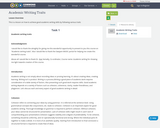
This is a lesson on how to achieve good academic writing skills by following various traits
- Subject:
- Literature
- Material Type:
- Lesson Plan
- Author:
- Kiran Shatiya
- Date Added:
- 10/27/2019

This is a lesson on how to achieve good academic writing skills by following various traits
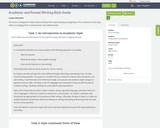
This lesson is designed to help students develop their understanding and application of an academic formal style, while encouraging them to develop their own individual style.
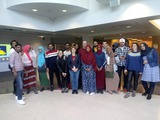
During the Spring 2020 semester, I taught this wonderful group of ESL learners in the classroom and on Zoom after the pandemic hit. This OER is a collection of resources, teaching ideas, and student artifacts about that experience. I hope it helps you. If you have questions, or just want to brainstorm, feel free to email me at <mike.mutschelknaus@rctc.edu>.
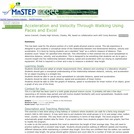
Using students' step length to understand the relationship between distance, speed and acceleration. Includes graphing of data and interpretation of graphs.
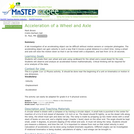
Students make a wheel and axle out of cardboard and a wooden dowel. It is rooled along a ramp made of parallel meter sticks, and the acceleration can be made small enough to make accurate measurements and calculations.
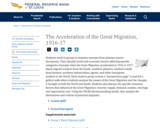
Students work in groups to examine excerpts from primary source documents. They identify social and economic factors affecting specific categories of people when the Great Migration accelerated in 1916 to 1917: black migrant workers from the South, southern planters, southern small-farm farmers, northern industrialists, agents, and white immigrant workers in the North. Each student group creates a "perspectives page" to post for a gallery walk where students analyze the causes of the Great Migration and the changes it brought to both the North and South. Students also discuss the specific economic factors that influenced the Great Migration: scarcity, supply, demand, surplus, shortage, and opportunity cost. Using the PACED decisionmaking model, they analyze the alternatives and criteria of potential migrants.
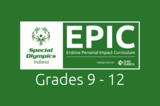
In this lesson, students will demonstrate their understanding of acceptance by developing a creative narrative that demonstrates the core theme of acceptance. The lesson includes a video clip, storyboard template, and rubric. This lesson is based on a video about the life of Carl Erskine, The Parallel book, and students’ research and perceptions of the concept.
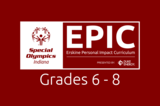
In this lesson, students learn about their classmates and teacher in a way that builds community and cohesiveness in the learning environment. Using the books, Playing for Change by Kelly Brown and The Parallel by Carl Erskine, as well as the Special Olympics video clip, Acceptance, students will discuss differences in the characters who were accepted and those who were not. In pulling these elements out of the plot, the students will then identify differences in themselves that possibly relate to others in the classroom.
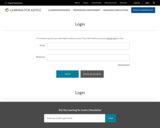
There is no doubt that modern lifestyle changes have contributed to the problems of overweight and obesity among adults and children. Some school health and physical education programs are tackling the challenge of integrating healthier eating and regular exercise into the lives of students. But what about the social challenges that face children who are overweight? And how do media messages reinforce the bias they already experience among many of their peers? In these lessons, students will evaluate both their own biases related to size differences and the ways in which media shape those biases.
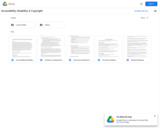
These materials are intended to be used both in graduate courses related to copyright or accessibility and by practitioners interested in learning more on the topic. Topics covered include the Chafee Amendment and how it has changed post-Marrakesh Treaty, the role of accessibility in the Authors Guild, Inc. v. HathiTrust decision, the importance of the Marrakesh Treaty for international efforts to make materials accessible across borders, and how licensing provisions can impact these various rights. The resources include videos explaining the key points of each topic, along with editable slide decks for those who wish to build on the existing materials, activities and options for assignments, recommended pre-class readings, discussion prompts, and related resources for those who want to learn more on the topics introduced in this OER module. There are also teaching notes for those interested in using the module in a class they are teaching.
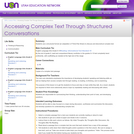
In this lesson students use a structured format (an adaptation of Think-Pair-Share) to discuss and deconstruct complex text. The new core standards emphasize the importance of developing students' speaking and listening skills as well as helping them access complex text through reading, re-reading, re-thinking, and re-examining.The purpose of this lesson is to get the students to focus and stay on topic while they talk. As a result, students are required to think more extensively about a topic by repeatedly reading and discussing with others.

This lesson is designed to help students learn to access health care on their own.

This lesson is designed to help students learn to access health care on their own.

This seminar discusses vocabulary dealing with accidents and how they occurred. Many of the words are in some form of the past tense that can help you write how something occurred and make it clear to a reader with details of how the event happened and the effects afterwards. ACTFL StandardsCommunications: Interpersonal Communication, Presentational CommunicationCommunities: School and Global CommunitiesLearning TargetI can write a short article on a current event.Habits of MindListening with understanding and empathyCritical Thinking SkillAnalyzing Perspectives
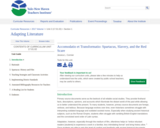
Primary source documents serve as the bedrock of all reliable social studies. They provide firsthand facts, descriptions, opinions, and accounts which illuminate the distant world of the past while allowing us to better understand the present. To many students, however, primary source documents are foreign, verbose, and tedious.
In order to reach out to these students, a history teacher’s best weapon is often adaptation, especially through the medium of film. Passionate actors, perceptive directors, witty screenwriters, and elaborate costumes bring dusty historical documents back to life through an immersive audiovisual experience.
Yet with a bit of inspection, these cinematic adaptations of history can reveal much more than secondary historical details. By analyzing these films as primary source documents themselves, audiences can gain insight into the time period in which the movies were made.
This curriculum unit considers the story of Spartacus—the celebrated hero of ancient history and the 1960 film directed by Stanley Kubrick—as both a primary and secondary source of history. How does Spartacus compare to the ancient sources recorded before the common era? And how does Spartacus reveal the political and social turmoil which afflicted the United States throughout the 1950’s and 1960’s?
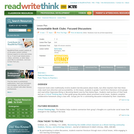
Students form literature circles, read "Esperanza Rising" or "Becoming Naomi Leon" by Pam MuĐoz Ryan, use a Critical Thinking Map to discuss social issues, and use a class wiki.

This lesson/activity is a supplement to textbook resources when teaching and reviewing adjusting entries for Supplies and Prepaid Insurance. By using candy (or other small items), students can record the transactions and have the visual inventory of items, thus emphasizing the need for adjusting entries.
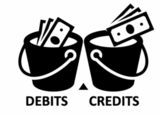
This lesson covers the basics of accounting. Things such as debits, credits, T accounts, and normal balance sides. Worksheet number one can be very helpful on future assignments.
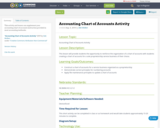
This activity and lesson can supplement your accounting chart of accounts instruction provided in most accounting textbooks.
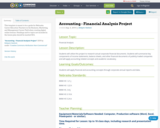
This template is meant to be a guide for Nebraska Career Education Teachers in the Business, Marketing, and Management Career Field when creating digital online lessons. Headings and/or topics not included in the lesson plan should be marked N/A.